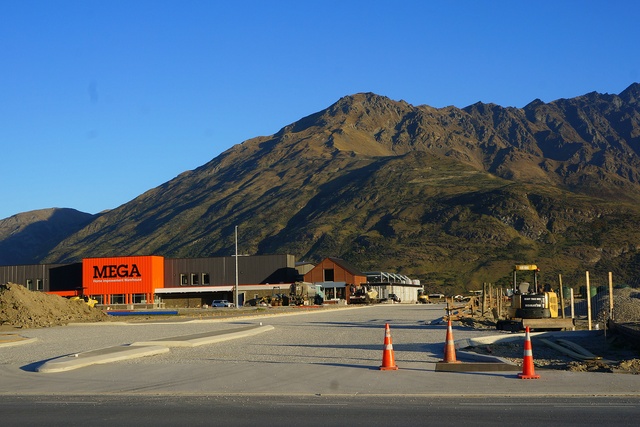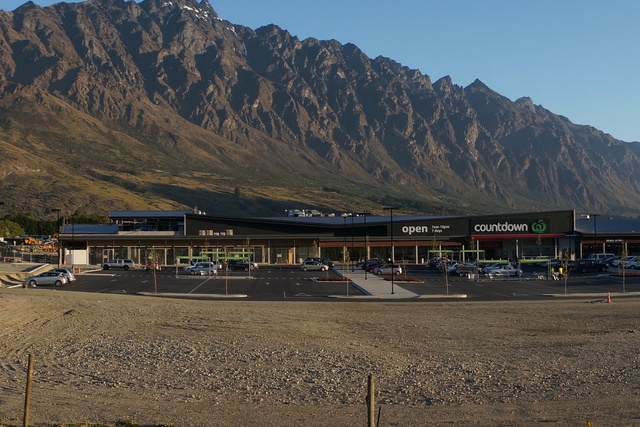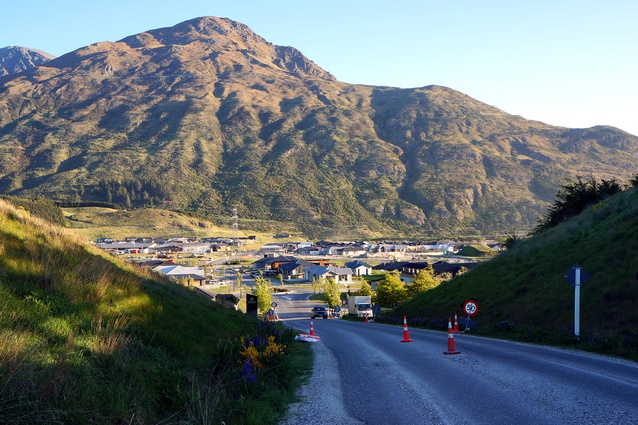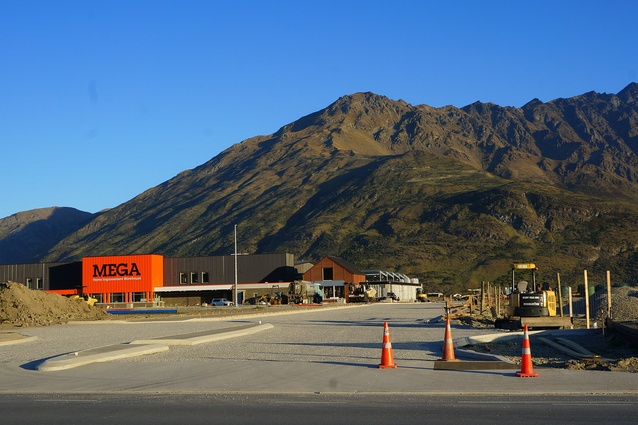Queenstown on the move
As landscape architects engage in balancing the reality of development with protection of our country’s most archetypal landscapes, public awareness of their role increases. Megan Ash from Baxter Design Group takes an indepth look at the issue, with a focus on Queenstown and the surrounding area.
Queenstown’s scenery, with its majestic mountains and stunning Lake Wakatipu, has cemented the region as one of New Zealand’s favorite visitor destinations. Year-round attractions and numerous wineries provide a range of adventures and activities that make Queenstown a tourist’s dream come true.
In the last five years Queenstown has rapidly changed. Visitor numbers have increased, the population has grown, and demand for land has surged – all of which have led to a development boom. Sudden expansion in a town can impact positively and negatively on day-to-day living, infrastructure and the landscape. The ultimate goal is about achieving a balance: between continuing development to support growth, and protecting the unique landscape and characteristics of a town that made it a desireable destination in the first place.
Some might assume that increased tourism alone is driving the development boom. However, it’s a compound dynamic that includes residential and commercial development, as well as tourism expansion. All three have an effect on the region’s economy – stimulating development, construction and investment activity.

Tourism is a large part of day-to-day life in Queenstown. On the surface, it’s what keeps the town running. Previously a very seasonal town, Queenstown has done extremely well to move beyond dependence on skiing and beautiful summers. Visitors are becoming increasingly aware that Queenstown is not just a winter destination, but is equally beautiful and offers myriad activities throught the year. The amount of tourists arriving daily is exceptional. To put it into perspective, the average daily population of residents is 30,700. The average daily population of visitors is 17,100 – that’s over half of the residential population arriving every day in search of accommodation, tourism activities and dining experiences.
To support increased tourism, local jobs and population have risen. Since 2006, residential population has increased by 33% from 22,959 to 30,700. Figures from the Shaping our Future Visitor Task Force show that visitor and residential growth are on a fairly equal curve – around a 4% increase per year. Extrapolated over time, if growth remains constant, every 20 years Queenstown will roughly double in both visitor and residential numbers.
This creates substantial presure on Queenstown, and how it will function and develop. Increased numbers in both locals and tourists creates demand on the town to expand. Locals seek affordable housing, a breadth and depth of jobs, schools and recreation facilities. Tourists require a range of activities, accommodation and on-going maintenance of the natural environment that largely draws them here.
Currently, Queenstown is a ship-in ship-out economy – we bring in everything we need, including visitors and workers, than send it all back out again. However, the town needs to settle into a self-reliant economy that supports a diverse range of people. The development boom is beginning to help achieve self-reliance, and it will continue to do so if done correctly. Adequate housing is a huge issue at the moment. So far, this has been tackled by developing out. Council agrees that urban sprawl cannot continue. Instead, we need to seriously consider developing up. This strategy includes considering mixed-use and high-density options.
Lack of housing has meant that landscape values are extremely important to established residents; but, often, not to those trying to settle here – their main driver is simply a place to live. High-density urbanisation around the town centre would protect the landscape. Less road capacity and less traffic on the roads reduces the requirement for infrastructure.

The issue stopping high-density urbanisation is the mindset of Kiwis. Everyone is after their ‘half-acre pavlova paradise’ with a stand-alone 3.5 bedroom house, double garage and large backyard. The reality is, we cannot continue to design this way to meet demand, and the cost of this dream has now escalated above the reach of most working Kiwis. If we continue developing large sections of rural land we risk losing the character of the town, traffic becomes a huge issue and we create isolated pockets of housing and retail with no connectivity. The rule of thumb with housing is to incentivise the behavior you want, and disincentivise that that you don’t.
One way the government is trying to tackle the housing shortage in Queenstown is to approve Special Housing Areas (SHA). Queenstown Lakes District Council may include criteria for qualifying developments within the Special Housing Areas (i.e. developments that can use the fast-tracked and more permissive planning and consenting processes). These criteria can include height limitations, a minimum number of dwellings and a percentage of affordable dwellings. Bridesdale, a development bordering Lake Hayes, is Queenstown’s first government-approved SHA. Most of the 147 lots sold out within a couple of days. Due to demand, similar SHA proposals are underway.
However, parallel infrastructure has yet to develop. One arterial route connects Queenstown to Arrowtown, with Frankton in the middle. Along with the existing Lake Hayes Estate, 590 lots at Shotover Country are underway, and 147 proposed lots at Bridesdale. Add to this the Five Mile shopping development, Queenstown Central and Shotover Park Limited. Once Shotover Country and Bridesdale are completed, 737 new houses will exist. If each house has two cars, there could be 1,474 cars commuting on Queenstown’s one and only main road.
Council has stated that infrastructure is generally provided on a just-in-time basis. There is a maxim that building new roads to relive traffic congestion is like ‘fighting obesity by letting out one’s belt’ – widening roads seems to increase the demand for road space. Instead, emphasis needs to be on innovation – more effort and thought into public transport and links.
Even (as one council member described it) in a ‘degrading environment’, Queenstown will always be less degraded than where our tourists come from; but we cannot take our landscape for granted. Community and council must urgently look at how we live and make the necessary adjustments to ensure our environment can continue to support us. This will require quite a cultural shift and, most certainly, urbanisation. Council have in place some strategies and policies to ensure the landscape of the Lakes District is maintained as development continues. These strategies include:
• District Plan Review: Clear definitions of outstanding natural landscapes and natural features. Urban growth boundaries defined to ensure development occurs in areas where the landscape can absorb change, to safeguard rural character and landscape values.
• Medium to High Density Zones: There is vociferous opposition from those who feel their backyard is under threat, but we cannot keep our characteristic rural landscape if we continue with the ‘half-acre pavlova paradise’ mind-set. Encouragement is needed to develop up rather than out.
• Urban Design: Council corporate submission on the District Plan review will lead to urban design guidelines for these zones. The proposed district plan would not be strong enough on urban design without them.
• Special Housing Areas: Ensuring SHAs are suitable, good quality, in the right place, affordable and include community retention mechanisms.
Good urban development enhances quality of life by shaping the spaces of human settlement with the intention to improve not just the beauty of a place, but to allow better interaction between people; and between people and the environment. It is not merely a physical design process, but a balancing of political, economic, cultural and physical factors. The immensely broad base of knowledge, context and understanding required means that urban design is collaborative work involving a range of professions.
One of the biggest positives to the development boom has been the increase in awareness of what we do as landscape architects. People are becoming more concious that sustainable development must be looked at in context – the landscape, rather than buildings alone – and the importance of engaging a landscape architect from the beginning.
Charles Waldheim said: “landscape replaces architecture as the basic building block.” The profound implication is that landscape architects and planners must emerge as the professions that will lead the way into the future, carrying the banner of holistic environmental design.

Area 1 - Queenstown Central: Proposed Queenstown conventation centre, hot pools and accomodation.
Area 2 - Queenstown Central: Rezoning of Gorge Road to high-density.
Area 3 - Queenstown Hill/ Frankton Road: Ongoing medium-density subdivisions offering mid-to-premium entry-level properties.
Area 4 - Kelvin Heights: Ongoing low-density subdivisions.
Area 5 - Frankton: Retail/mixed use developments including: A) Five Mile (retail) B) Queenstown Central (retail and mixed use) C) Shotover Park (retail) D) Queenstown Aiport Expansion E) The Landing (retail) F) Remarkable Park activity area G) Ramada Hotel H) Wakatipu high school relocation.
Area 6 - Shotover Country: Low-density entry-level housing development.
Area 7 - Bridesdale: SHA medium- and low-density housing development.
Area 8 - Remarkables Ski Field: Ongoing development and resealing of the road.
Area 9 - Jack’s Point: Ongoing development.












